Countries
Japan
Andora, Argentina, Aruba, Australia, Belize, Bolivia, Brazil, Canada, Chile, Colombia, Costa Rica, Cuba, Dominican Republic, Ecuador, El Salvador, Equatorial Guinea, France, Gibraltar, Guatemala, Honduras, Jamaica, Latvia, Luxembourg, Mexico, Morocco, Namibia, Netherlands Antilles, New Zealand, Nicaragua, Norway, Panama, Paraguay, Peru, Philippines, Puerto Rico, Russia, Spain, Sweden, Switzerland, Trinidad and Tobago, Turkey, United Kingdom, United States of America, Uruguay, Venezuela, Western Sahara
National Language
Japan
Spain
Second Language
Not spoken in any of the countries
Andora, Aruba, Australia, Austria, Belgium, Belize, Brazil, Bulgaria, Canada, Denmark, France, Germany, Ireland, Israel, Italy, Jamaica, Luxembourg, Morocco, Netherlands, Netherlands Antilles, New Zealand, Philippines, Poland, Portugal, Romania, Russia, Slovenia, Switzerland, Trinidad and Tobago, Turkey, United Kingdom, United States of America, US Virgin Islands
Speaking Continents
Asia, Pacific
Africa, Asia, Europe, North America, South America
Minority Language
Palau
Brazil, France, Germany, Italy, Japan, Morocco, United Kingdom
Regulated By
Agency for Cultural Affairs (文化庁) at the Ministry of Education
Asociación de Academias de la Lengua Española
Interesting Facts
- In Japanese Language, there are 4 different ways to address people: kun, chan, san and sama.
- There are many words in Japanese language which end with vowel letter, which determines the structure and rhythm of Japanese.
- One of the world's most phonetic language is Spanish.
- Up to the 18th century, Spanish was diplomatic language.
Similar To
Korean Language
French Language
Derived From
Not Available
Latin
Alphabets in
Japanese-Alphabets.jpg#200
Spanish-Alphabets.jpg#200
Writing Direction
Left-To-Right, Horizontal, Top-To-Bottom
Left-To-Right, Horizontal
Hello
こんにちは (Kon'nichiwa)
hola
Thank You
ありがとう (Arigatō)
Gracias
How Are You?
お元気ですか (O genki desu ka?)
Cómo estás?
Good Night
おやすみなさい (Oyasuminasai)
Buenas Noches
Good Evening
こんばんは (Konbanwa)
Bonne soirée
Good Afternoon
こんにちは (Konnichiwa!)
Buenas Tardes
Good Morning
おはよう (Ohayō)
Buenos Días
Please
お願いします (Onegaishimasu)
Por Favor
Sorry
ごめんなさい (Gomen'nasai)
triste
Bye
さようなら (Sayōnara)
adiós
I Love You
愛しています (Aishiteimasu)
Te Quiero
Excuse Me
すみません (Sumimasen)
Discúlpeme
Dialect 1
Sanuki
Mexican Spanish
Where They Speak
Kagawa
Mexico
Dialect 2
Hakata
Cuban Spanish
Where They Speak
Fukuoka
Cuba
How Many People Speak
Not Available
Dialect 3
Kansai
Puerto Rican Spanish
Where They Speak
kansai
Puerto Rico
How Many People Speak
Not Available
Second Language Speakers
Not Available
Alternative Names
Not Available
Castellano, Castilian, Español
French Name
japonais
espagnol; castillan
German Name
Japanisch
Spanisch
Pronunciation
/nihoɴɡo/: [nihõŋɡo], [nihõŋŋo]
[espaˈɲol], [kasteˈʎano]
Ethnicity
Japanese (Yamato)
Not Available
Language Family
Japonic Family
Indo-European Family
Subgroup
Not Available
Romance
Branch
Not Available
Not Available
Early Forms
Old Japanese, Early Middle Japanese, Late Middle Japanese and Early Modern Japanese
Old Spanish and Spanish
Standard Forms
Japanese
Pluricentric Standard Spanish
Signed Forms
Signed Japanese
Signed Spanish
Scope
Individual
Individual
ISO 639 6
Not Available
Not Available
Glottocode
nucl1643
stan1288
Linguasphere
45-CAA-a
51-AAA-b
Language Type
Living
Living
Language Linguistic Typology
Subject-Object-Verb
Subject-Object-Verb
Language Morphological Typology
Agglutinative, Synthetic
Fusional, Synthetic
Japanese and Spanish Greetings
People around the world use different languages to interact with each other. Even if we cannot communicate fluently in any language, it will always be beneficial to know about some of the common greetings or phrases from that language. This is where Japanese and Spanish greetings helps you to understand basic phrases in Japanese and Spanish language. Japanese word for "Hello" is こんにちは (Kon'nichiwa) or Spanish word for "Thank You" is Gracias. Find more of such common Japanese Greetings and Spanish Greetings. These greetings will help you to be more confident when conversing with natives that speak these languages.
Japanese vs Spanish Difficulty
The Japanese vs Spanish difficulty level basically depends on the number of Japanese Alphabets and Spanish Alphabets. Also the number of vowels and consonants in the language plays an important role in deciding the difficulty level of that language. The important points to be considered when we compare Japanese and Spanish are the origin, speaking countries, language family, different greetings, speaking population of these languages. Want to know in Japanese and Spanish, which language is harder to learn? Time required to learn Japanese is 88 weeks while to learn Spanish time required is 24 weeks.





